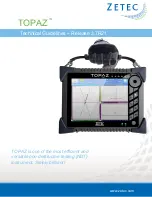
35
REER S.p.A. - Via Carcano, 32 - 10153 Torino, Italy - Internet: www.reersafety.com - e-mail: [email protected]
8541205 - rev
.1 - 02/09/2019
Electrical connections/Operating modes
RESTART (MANUAL OPERATION)
Î
Refer to “APPENDIX A1: SM - SMO MODELS WIRING SAMPLES - MANUAL MODE”, page 37.
Pin 10 has RESTART function. As a result of occupation of the protected area, OSSDs outputs will be
deactivated (OFF) (Manual mode - start/restart interlock enabled).
Î
To reactivate OSSDs press and release the N.O. RESTART pushbutton connected to 24VDC. Verify the
logical sequence: 0 → 1 → 0.
¾
The high level (24Vdc) time must be between 100 ms and 5 s.
Use in manual mode (start/restart interlock enabled) is mandatory in case the safety device
controls a gate to protect a dangerous area and a person, once crossed the gate, can stay
in the hazardous area without being detected (use as a ‘trip device’ according to IEC 61496).
The Restart command must be located outside the hazardous area, at a point where the
hazardous area and the entire working area concerned are clearly visible.
It must not be possible to reach the command from inside the hazardous area.
AUTOMATIC OPERATION
Î
“APPENDIX A2: SM - SMO MODELS WIRING SAMPLES - AUTOMATIC MODE”, page 39
In Automatic operating mode, the OSSD1 and OSSD2 safety outputs follow the status of the light curtain:
¾
with guarded area free, the outputs are ON.
¾
with guarded area occupied, the outputs are OFF.
If the SAFEGATE light curtain is used in AUTOMATIC mode, it will not be equipped with
a start/restart interlock circuit. In most applications, this safety function is mandatory.
Carefully evaluate the risks analysis of your own application.
OVERRIDE1
RESTART (10)
SAFEGA
TE
ACTIVE ELEMENT
AUTOMATIC
SAFEGA
TE
ACTIVE ELEMENT
MANUAL
N.C.
OVERRIDE1
RESTART (10)
24Vdc
RESTART
















































